Gerald R. Ford Presidential Museum
The Gerald R. Ford Presidential Museum is the presidential museum and burial place of Gerald Ford, the 38th President of the United States (1974–1977), and his wife Betty Ford. It is located near the Pew Campus of Grand Valley State University in Grand Rapids, Michigan. Ford's presidential museum is the only such facility under the auspices of the National Archives and Records Administration to be separate from the presidential library, which is located approximately 130 miles (210 km) to the east in Ann Arbor. Despite the separation, the library and museum are a single institution with one director.
| Gerald R. Ford Presidential Museum | |
|---|---|
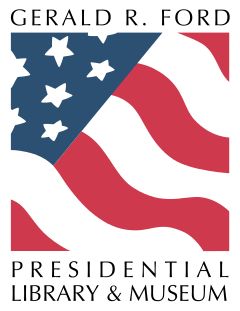 | |
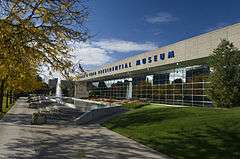 | |
 Location in Michigan  Gerald R. Ford Presidential Museum (the United States) | |
| General information | |
| Location | Grand Rapids, Kent County, Michigan, United States |
| Coordinates | 42.966779°N 85.677341°W |
| Named for | Gerald Ford |
| Construction started | January 7, 1976 |
| Inaugurated | Dedicated on September 18, 1981 |
| Cost | $11 million |
| Management | National Archives and Records Administration |
| Technical details | |
| Size | 44,000 sq ft (4,100 m2) |
| Design and construction | |
| Architect | Marvin DeWinter Associates; Jordan Sheperd |
| Website | |
| fordlibrarymuseum | |
Gerald Ford
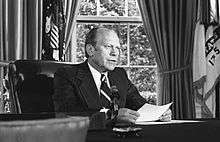
Gerald Rudolph Ford, Jr. (born Leslie Lynch King, Jr.) was born on July 14, 1913. Ford served nearly 25 years as a Representative of Michigan's 5th congressional district, eight of them as the Republican Minority Leader. Serving from 1973 to 1974 as the 40th Vice President of the United States, Ford was the first person appointed to the vice-presidency under the terms of the 25th Amendment. He then became President upon Richard Nixon's resignation on August 9, 1974, and served until January 20, 1977 as the 38th President of the United States. Ford is the only President of the United States who was not elected by ballot for his terms as either President or Vice-President.
Building and dedication of the museum
Funds for the construction of the museum were raised from over 14,000 individual donations through the efforts of the Gerald Ford Commemorative Committee, the University of Michigan, the State of Michigan, Kent County, and the City of Grand Rapids.
The 44,000-square-foot (4,100 m2) two-story triangular museum was designed by Marvin DeWinter Associates and built at a cost of $11 million. The museum is one of the highlights in a 20-acre (8.1 ha) park complex that includes the Grand Rapids Public Museum along the west bank of the Grand River in downtown Grand Rapids. The building was dedicated September 18, 1981, with a gala celebration attended by President and Mrs. Reagan, President José López Portillo of Mexico, Canadian Prime Minister Pierre Trudeau, Japan's Minister of Foreign Affairs Sunao Sonoda, former French President Valéry Giscard d'Estaing, and former Secretary of State Henry Kissinger. Bob Hope served as master of ceremonies and part of the festivities were recorded for TV broadcast.[1] The east side of the structure is enclosed by a 300-foot-wide (91 m) glass wall providing a view of the river and downtown Grand Rapids beyond. The main entrance features a reflecting pool and fountain to welcome visitors. The site is linked with downtown hotels and shops by a pedestrian bridge spanning the river.
The core exhibits were completely redesigned as part of a major building expansion completed in 1997 allowing for a broader program of changing feature exhibits and events. Expanded funding from the Gerald R. Ford Foundation supported the expansion and expanded programming.
Museum exhibits
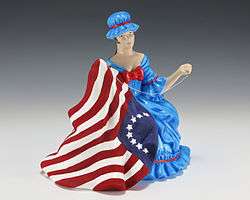
The main floor contains exhibits on President Ford's life and career as President of the United States. Candid photographs of Ford interacting with his family and colleagues offer the visitor a personal glimpse of the president. This floor includes a full-scale replica of the Oval Office furnished as it was during Ford's presidency.[2]
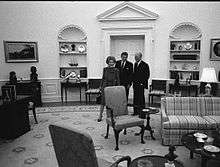
Special exhibits highlight the 1976 Bicentennial celebration[3] and Mrs. Ford's role during her husband's term in office. Other exhibits, which are the core of the museum's program, enable visitors to travel by video with President Ford and Secretary Kissinger to various hot-spots around the globe; take a holographic tour of the Ford White House; and experience a day in the Oval Office through a sound and light show. A Watergate gallery includes a six-minute, multi-screen history beginning with the June 1972 break-in and a display of the actual burglary tools. An interactive Cabinet Room allows visitors to take part in presidential decision making. Visitors can see gifts presented by heads of state and other foreign dignitaries, as well as personal gifts to Ford from the American people. The award-winning film, "A Time To Heal," is shown hourly in the museum auditorium. A section of the Berlin Wall stands in the museum's lobby, which was dedicated by Ford on September 6, 1991.[4]
In addition to the permanent exhibits, a succession of temporary exhibits draws upon the rich holdings of the entire Presidential libraries system, the Smithsonian Institution, the National Archives, and others.
Museum collections
The museum collections houses approximately 20,000 artifacts from the life and career of President Ford. Mrs. Ford's life is represented as well. Artifacts include Boy Scout materials, head of state gifts, bicentennial materials, re-election campaign materials, and clothing.
Educational and community programs
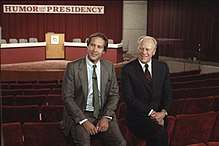
The Gerald R. Ford Presidential Library and Museum are sponsored by the Gerald R. Ford Presidential Foundation whose mission is to support historical exhibits, educational programs, conferences, research grants, and awards. In addition to providing funding for the library and museum, the foundation publishes a semi-annual report of activities, sponsors the William E. Simon Lectures in Public Affairs, awards journalism prizes for excellence in reporting on the presidency and defense issues and awards grants-in-aid of up to $2,000 to researchers who use the Ford Library archival holdings. Another part of the foundation's mission is to honor the principles and values demonstrated by Gerald Ford throughout his public service career.
With the assistance of the Ford Presidential Foundation, the museum sponsors scholarly conferences and community activities independently or in conjunction with other organizations such as the University of Michigan and the Domestic Policy Association.
Museum staff organizes and hosts special events that range from period fashion shows to activities for school children and in-service workshops for area teachers. The museum annually hosts naturalization ceremonies for new citizens and opens the grounds to community festivities and Independence Day fireworks. Other regular programs at the museum include the Great Decisions Lecture Series which brings guest speakers on selected foreign policy topics and features audience discussions and completion of "opinion ballots". It maintains an ongoing partnership with the Close Up Foundation that encourages student awareness of public issues and sponsors a Citizens Bee, a competitive exam for high school students with questions focused on history and political affairs. The American Political Film Series annually presents eight motion pictures that frequently deal with highly charged topics for discussion. At Christmas time, area youth are invited to create ornaments for the large tree in the museum lobby.
In the media
The library was the taping site of a PBS series on The Presidency and the Constitution that aired in 1987. In December 1988, it hosted a gathering of representatives from 44 nations for an All-Democracies Conference. Perhaps the most popular conference sponsored by the library and museum was Humor and the Presidency held at the museum September 17–19, 1986.[5] The conference featured presentations by politicians, well-known comedians, press secretaries, newspaper columnists, and political cartoonists to explore all sides of the topic. President Ford and Chevy Chase appeared on several morning news/talk shows generating wide interest in the event. The conference was taped for later broadcast on HBO.
The Fords' funerals
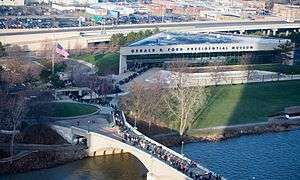
Following Gerald Ford's death on December 26, 2006, thousands of people paid tribute to the president on the grounds of the museum. Visitors created a spontaneous memorial with candles, flags, flowers, and handwritten notes at the Pearl Street entrance. During the night of January 2, 2007, through the morning of January 3, approximately 60,000 people viewed the casket as Ford lay in repose in the museum lobby.[6] On January 3, Ford's body was taken to Grace Episcopal Church in East Grand Rapids for a funeral service. During the service, former President Jimmy Carter, former Defense Secretary Donald Rumsfeld, and historian Richard Norton Smith gave eulogies.[7] Following the service, President Ford was interred on the museum grounds.
After Betty Ford's death on July 8, 2011, the museum closed the following day to prepare for her funeral. Throughout the closure, the lobby remained open for guests to sign a condolence book.[8] Later that day, the Ford family announced that her casket would be returned to Grand Rapids and lie in repose at the museum for public visitation from the evening of July 13 through noon July 14, when a service was held at Grace Episcopal Church. After the service, the casket was returned to the museum for burial next to her husband.[9]
Permanent exhibits
- Gerald Ford's America: pop culture of the 1970s.
- Young Jerry Ford: His formative years to inauguration as vice president.
- Constitution in Crisis: The Watergate years.
- At Work in the Oval Office: A recreation of the Oval Office during Ford's years as President of the United States.
- Leadership in Diplomacy: Ford's foreign trips with Secretary of State Henry Kissinger.
- Ford Cabinet Room: A recreation of the Cabinet Room of the Ford Presidency. Videos highlight the pardon of Richard Nixon, the seizure of the SS Mayagüez, and the New York City financial crisis.
Temporary exhibits
The Gerald R. Ford Presidential Museum offers visitors an ever-changing array of temporary exhibits. Along with hosting major traveling exhibits from public and private institutions, the museum also develops major temporary shows in-house. Some notable exhibits include:
All That Jazz
America in the 1920s (January 31 – June 13, 2004)
The drama of one of the most significant decades in America's history unfolded in this unique look at the Jazz Age. Few decades have been filled with so much yet ended so quickly as the 1920s. Businesses boomed, the stock market soared, and heroes were abundant. Before the 1920s ended in the worst stock market crash in history, America underwent a transformation from 19th century Victorian life and business to a 20th-century dynamo, setting the standard for a transformed society and industrial giant. This special exhibit featured Richard Byrd's polar flight suit, Man o' War's saddle, a brick from the St. Valentine's Day Massacre, a suit worn by Henry Ford, Ernest Hemingway's passport, Charles Lindbergh's flight goggles, a painting by Zelda Fitzgerald, a costume worn by Al Jolson, Bill Tilden's tennis racket, Louis Armstrong's trumpet, Babe Ruth's Yankees uniform, and much more.[10]
Opening an Empire
U.S. Relations with China (October 15, 2004 – March 13, 2005)
While vibrant and growing, China remained isolated from the world until only the last few centuries. This special exhibit allowed visitors to view the ancient art and culture of the world's most populated nation as it rose from isolation into a leading global power. Opening an Empire explored China from its first emperor to Kublai Khan to the Boxer rebellion. China's emergence into the 20th century and unique relations with the United States were also featured. Artifact highlights included: weapons used during the Boxer Rebellion, Chairman Mao items, the 1844 Treaty of Wangxia (the first treaty signed between China and the U.S.), early tea trade artifacts, Head of State gifts to ten different U.S. Presidents, and artifacts from every Chinese Dynasty.[11]
Theodore Roosevelt
A Singular Life (October 7, 2005 – March 5, 2006)
Vibrant America at the dawn of the 20th century was poised, yet hesitant, to step onto the world stage. Theodore Roosevelt, embodying the energy and promise of the New World, came at this opportune time. In eight years, he made America's presence felt across the globe, looked out for the common man, fought injustice wherever he saw it, and took on the political bosses and industrialists. And, if his two heroes George Washington and Abraham Lincoln defined the presidency, he modernized it to fit a changing world. Exhibit highlights included: the flag carried by the Rough Riders' as they charged San Juan Hill, the capstan from USS Maine, a diary kept by Roosevelt during his youth, 1898 Treaty of Paris, President McKinley assassination items, Roosevelt's naval cape worn during his presidency, "Big Medicine" (Roosevelt's famous safari hunting rifle), along with a lion, zebra, and rhino all collected by Roosevelt while on safari.[12]
Slavery on Trial
The Long Road to Freedom (December 8, 2006 through April 29, 2007)
From the earliest days of slavery in the then-Thirteen Colonies to the end of the Civil War, Slavery on Trial traced the history of this dreadful practice through the life of Dred Scott and his family. Over 100 artifacts and documents were displayed, including the earliest known Eli Whitney cotton gin, the noose used to hang John Brown, Frederick Douglass' bill of sale, the Missouri Compromise, a first edition of Uncle Tom's Cabin, Daniel Webster's personal effects, the actual Dred Scott Supreme Court Decision, a United States Colored Troops (USCT) regimental flag carried during the Civil War, a copy of the Emancipation Proclamation signed by Abraham Lincoln, Charles Sumner's Senate chair, a slave-made quilt, and chains used to shackle slaves.[13]
America and the Cold War
Four Decades that Changed the World (January 22 – June 13, 2010)
World War II was the most devastating conflict in history with much of Europe and Asia left in ruins at war's end. Yet, there was no peace. The superpowers of the United States and Soviet Union and their ideologies of democracy versus tyranny competed for prominence on the world stage in a cold war. For over 40 years these nuclear superpowers maintained a standoff and avoided a hot war that could have potentially destroyed the planet. America and the Cold War explored this powerful subject through such iconic artifacts as: an original 34' Nike Ajax missile, arming plug used to activate the bomb used on Hiroshima, Thunderbolt Air Raid siren, SALT I Treaty, scale model of Apollo-Soyuz, candy parachute from the Berlin Airlift, Stasi surveillance equipment, and a desk plaque awarded to the crew members of the Soviet SA-2 missile battalion that shot down Francis Gary Powers U-2 spy plane in 1960.[14]
Taking the Seas
Rise of the American Aircraft Carrier (July 14, 2014 – April 26, 2015)
For one hundred years, aircraft carriers have launched their planes over the seas, assuring the fleet and soldiers ashore air superiority and support in the far-flung corners of the map, where leaders determine our interests are at risk. They are the largest, most powerful warships ever to plow the waves, monuments to our nation's strength, ready to respond to crises abroad. The Taking the Seas: The Rise of the American Aircraft Carrier exhibit explores the development of this unique ship and the role it plays in projecting our nation's influence abroad. An assortment of iconic artifacts and documents illuminate the evolution of aircraft carriers from experimental ship conversions to modern-day, nuclear behemoths. Highlights include: the Washington Naval Treaty of 1922, the Lend-Lease Act of 1941, Mitsuo Fuchida's map of Pearl Harbor, Jimmy Doolittle's Medal of Honor, uniform worn by Admiral Chester William Nimitz, scale model of USS United States, Admiral Hyman George Rickover artifacts, life ring from USS Forrestal, and a scale model of USS Gerald R. Ford.
References
- Tucker, Brian (September 18, 1981). "Reagan Praises Ford at Opening of Museum". The Boston Globe. Associated Press. Retrieved February 26, 2014.
- "At Work in the Oval Office". Gerald R. Ford Presidential Library and Museum. Retrieved July 30, 2012.
- "Bicentennial Artifacts". Gerald R. Ford Presidential Library and Museum. Retrieved August 3, 2012.
- "Use of the Museum Facility". Gerald R. Ford Presidential Library and Museum. Retrieved July 5, 2011.
- "Timeline of President Ford's Life and Career". Gerald R. Ford Presidential Library and Museum. January 11, 2007. Retrieved July 5, 2011.
- Deiters, Barton; Murray, Dave; Kolker, Ken (January 3, 2007). "This Is a Day of History ... and We Should Be Here". The Grand Rapids Press. Retrieved July 9, 2011.
- Rademacher, Tom (January 3, 2007). "Service to Include Ordinary Mourners". The Grand Rapids Press. Retrieved July 8, 2011.
- "Betty Ford's Legacy: Candor and Inspiration". CNN. July 9, 2011. Retrieved July 9, 2011.
- "Services and Funeral Plans Set for Betty Ford". Detroit Free Press. July 9, 2011. Retrieved July 9, 2011.
- "All That Jazz: America in the 1920s". Gerald R. Ford Presidential Library and Museum. Retrieved July 5, 2011.
- "Opening an Empire: U.S. Relations with China". Gerald R. Ford Presidential Library and Museum. Retrieved July 5, 2011.
- Kratas, Jim. "Teddy Roosevelt: A Singular Life". Grand Valley State University. Retrieved July 5, 2011.
- "Slavery on Trial, Long Road to Freedom". Gerald R. Ford Presidential Library and Museum. Retrieved July 5, 2011.
- "America and the Cold War: Four Decades that Changed the World". Gerald R. Ford Presidential Library and Museum. Retrieved February 23, 2012.
External links
| Wikimedia Commons has media related to Gerald R. Ford Presidential Library and Museum. |
- Gerald R. Ford Presidential Library and Museum website
- Gerald R. Ford Presidential Foundation website
- National Archives and Records Administration website
- "Life Portrait of Gerald R. Ford", from C-SPAN's American Presidents: Life Portraits, broadcast from the Gerald R. Ford Presidential Museum, November 22, 1999